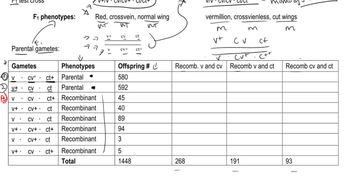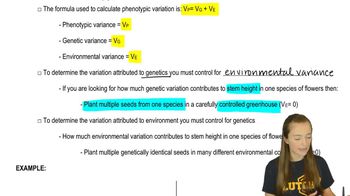Table of contents
- 1. Introduction to Genetics51m
- 2. Mendel's Laws of Inheritance3h 37m
- 3. Extensions to Mendelian Inheritance2h 41m
- 4. Genetic Mapping and Linkage2h 28m
- 5. Genetics of Bacteria and Viruses1h 21m
- 6. Chromosomal Variation1h 48m
- 7. DNA and Chromosome Structure56m
- 8. DNA Replication1h 10m
- 9. Mitosis and Meiosis1h 34m
- 10. Transcription1h 0m
- 11. Translation58m
- 12. Gene Regulation in Prokaryotes1h 19m
- 13. Gene Regulation in Eukaryotes44m
- 14. Genetic Control of Development44m
- 15. Genomes and Genomics1h 50m
- 16. Transposable Elements47m
- 17. Mutation, Repair, and Recombination1h 6m
- 18. Molecular Genetic Tools19m
- 19. Cancer Genetics29m
- 20. Quantitative Genetics1h 26m
- 21. Population Genetics50m
- 22. Evolutionary Genetics29m
20. Quantitative Genetics
Analyzing Trait Variance
Problem 22b
Textbook Question
Suppose a polygenic system for producing color in kernels of a grain is controlled by three additive genes, G, M, and T. There are two alleles of each gene, G₁ and G₂, M₁, and M₂, and T₁ and T₂. The phenotypic effects of the three genotypes of the G gene are G₁G₁ = 6 units of color, G₁G₂ = 3 units of color, and G₂G₂ = 1 unit of color. The phenotypic effects for genes M and T are similar, giving the phenotype of a plant with the genotype G₁G₁M₁M₁T₁T₁ a total of 18 units of color and a plant with the genotype G₂G₂M₂M₂T₂T₂ a total of 3 units of color. Two trihybrid plants are mated. What is the expected proportion of progeny plants displaying 9 units of color? Explain your answer.
 Verified step by step guidance
Verified step by step guidance1
Identify the contribution of each gene to the color units. For each gene (G, M, T), the homozygous dominant genotype contributes 6 units, the heterozygous genotype contributes 3 units, and the homozygous recessive genotype contributes 1 unit.
Determine the total color units needed for the progeny to display 9 units of color. This can be achieved by different combinations of genotypes across the three genes.
List all possible genotype combinations that result in a total of 9 units of color. For example, one such combination could be G₁G₂ (3 units) + M₁M₂ (3 units) + T₁T₂ (3 units).
Calculate the probability of each genotype combination occurring in the progeny. Since the parents are trihybrid (G₁G₂M₁M₂T₁T₂), use the Punnett square or probability rules to find the likelihood of each genotype.
Sum the probabilities of all genotype combinations that result in 9 units of color to find the expected proportion of progeny with this phenotype.
Recommended similar problem, with video answer:
 Verified Solution
Verified SolutionThis video solution was recommended by our tutors as helpful for the problem above
Video duration:
3mPlay a video:
Was this helpful?
Key Concepts
Here are the essential concepts you must grasp in order to answer the question correctly.
Polygenic Inheritance
Polygenic inheritance refers to the phenomenon where multiple genes contribute to a single trait, resulting in a continuous range of phenotypes. In this case, the color of the grain kernels is influenced by three additive genes (G, M, and T), each with two alleles. The cumulative effect of these genes leads to various color intensities, demonstrating how traits can be quantitatively inherited rather than following simple Mendelian patterns.
Recommended video:
Guided course

Organelle Inheritance
Additive Gene Effects
Additive gene effects occur when the contributions of different alleles combine to produce a phenotype. For example, in the given scenario, the G gene has different phenotypic effects based on its genotype, with G₁G₁ contributing the most color. Understanding how these additive effects work is crucial for predicting the phenotypic outcomes of crosses between plants with multiple gene interactions.
Recommended video:
Guided course

Maternal Effect
Expected Proportions in Genetic Crosses
Expected proportions in genetic crosses can be calculated using the principles of probability and the genotypic ratios derived from Punnett squares. In this case, by determining the possible combinations of alleles from the trihybrid plants and their corresponding phenotypic contributions, one can predict the proportion of progeny that will exhibit a specific phenotype, such as 9 units of color, based on the additive effects of the involved genes.
Recommended video:
Guided course

Trihybrid Cross

 8:34m
8:34mWatch next
Master Analyzing Trait Variance with a bite sized video explanation from Kylia Goodner
Start learningRelated Videos
Related Practice


